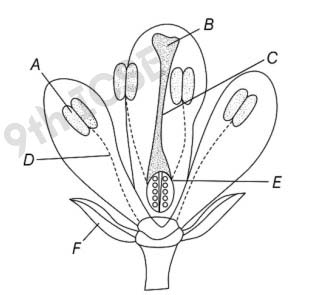Q1 How are essential whorls are more important than non-essential whorls?
Solution :
• Androecium and gynoecium are the essential or reproductive whorls of
the flower. These are male and female parts and are directly involved in
sexual reproduction and production of seeds.
• The non-essential whorls : Calyx protects the inner whorls in the bud stage
Corolla attracts insects for pollination.

Q2 Differentiate between monoecious and dioecious flowers.
Solution :

Q3 Find the odd one out:-
(i) Petals, calyx, corolla, androecium
(ii) Style, stigma, stamen, ovary
Solution :
(i) All words except androecium describe the parts that are not essential
whorls of the flower so, androecium is odd word.
(ii) Stigma, style and ovary make one carpel. Stamen is a odd word in this
series.
Q4 Give technical terms for the following:
(i) When all the carpels are united
(ii) Undifferentiated calyx and corolla
(iii) Flower bearing main axis
(iv) A flower in which stamens are absent
(v) Arrangement of ovules in the ovary
Solution :
(i) Syncarpous
(ii) Perianth
(iii) Inflorescence
(iv) Incomplete flower
(v) Placentation
Q5 Define inflorescence and its types.
Solution :
Arrangement of flower on the axis is called inflorescence. Its two main types
are:
(i) Racemose (ii) Cymose

Q6 How are flowers classified based on the position of ovary?
Solution :
(i) Hypogynous flower: Ovary is superior as it occupies highest position on
thalamus, whereas rest of the floral structures are inferior, e.g. Brassica,
Hibiscus, Petunia.
(ii) Perigynous flower: The thalamus grows upwards forming a cup-like
structure around the ovary. The ovary is half inferior, e.g. rose, plum, peach,
etc.
(iii) Epigynous flower: The thalamus surrounds and encloses the ovary. The
ovary is called inferior, e.g. Helianthus (sunflower), Cucurbita (pumpkin), Pyrus
(apple).

Q7 Define the following terms:
(i) Hypogynous ovary
(ii) Pedicel
(iii) Polypetalous
(iv) Unisexual
(v) Incomplete flower
Solution :
(i) Hypogynous ovary When all the parts of flower except female reproductive
structures rise above the ovary, then ovary is said to be hypogynous.
(ii) Pedicel The stalk of the flower is called pedicel.
(iii) Polypetalous When petals of flower are free from each other and are not
fused, the condition of the flower is called polypetalous.
(iv) Unisexual A flower which contains either male or female reproductive
part, then it is called unisexual flower, e.g. Cucurbita, papaya.
(v) Incomplete flower When a flower contains only one essential whorl out of
two, i.e. gynoecium or androecium, the flower is said to be incomplete flower.
Q8 Answer the following questions:

(i) Name the part marked as A-F.
(ii) Which part produces pollen grains?
(iii) Which part receives pollen grains?
(iv) Which part develops into fruit after fertilisation?
Solution :
(i) A-Anther B-Stigma C-Style D-Filament E-Ovary F-Calyx
(ii) Anther
(iii) Stigma
(iv) Ovary
Q9 Describe a typical gynoecium.
Solution :
• It is the female reproductive part of the flower. It is made up of one or
more carpels or megasporangium.
• A carpel consists of three parts, i.e., stigma, style and ovary.
• The stigma is usually at the tip of style and is the receptive surface for
pollen grains.
• The style connects the ovary to the stigma.
Ovary is the enlarged basal part on which lies the elongated tube the
style. Each ovary bears one or more ovules attached to a flattened,
cushion-like placenta.

Q10 Differentiate between the following:
(i) Gamosepalous and polysepalous
(ii) Actinomorphic and zygomorphic flower
(iii) Style and filament
Solution :
(i) When sepals are fused its gamosepalous and when sepals are free it is
polysepalous calyx.
(ii) Actinomorphic flower can be divided into two equal
halves from any plane
(e.g. mustard, Datura) while zygomorphic flower is divided into two equal
halves only at one plane (e.g. Pea, Salvia).
(iii) Style is part of carpel which holds stigma connecting it to the ovary and
filament is a part of androecium which holds anther.







